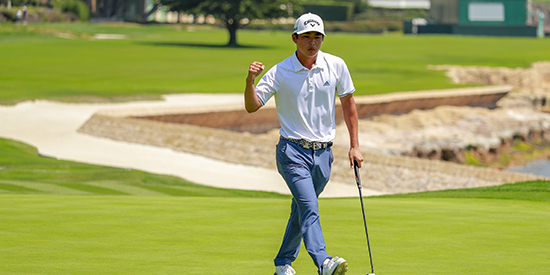
Shintaro Ban (USGA photo)
PEBBLE BEACH, Calif. (Aug. 14, 2018) –
Shintaro Ban cracked a long, though not quite desirable, streak when he gained entry into the U.S. Amateur at Pebble Beach. After four consecutive years as the first alternate, Ban finally made it back to the nation’s best amateur event -- and on home turf, no less.
Ban qualified for the U.S. Amateur on his first try in 2013. He was 17 years old and still in high school. He nearly finished last that year at the Country Club in Brookline, Mass., and sought a return trip each of the next four years. Near misses in his 36-hole qualifier drove home the point about how hard it is to gain access to the U.S. Amateur. Ban topped the alternate list every year, but never got the call.
Ban, a San Jose, Calif., native, could certainly dwell on that – get frustrated, press harder – but the now 22-year-old shrugs off what is truly a remarkable coincidence. If there’s a silver lining, it’s that missing the U.S. Amateur opened an opportunity to familiarize himself with Spyglass Hill, the companion course to this year’s Amateur.
Despite being on the cusp of entry, Ban never actually traveled to the U.S. Amateur site to hang around and wait for a withdrawal. Instead, he played Northern California Golf Association Match Play. In 2015, Ban lost to former Stanford standout Maverick McNealy in the semifinals. He won the event in 2016, then lost to Isaiah Salinda, a current Stanford senior and winner of last month’s Pacific Amateur, in 2017.
Now familiar with the course, Ban opened stroke-play qualifying on Monday with 1-under 71 at Spyglass Hill. It included a back-nine 3-under 33.
“Especially playing Spyglass the first time, it can be really tough,” Ban said. “I’d never seen the conditions like that (on Monday). The rough was really thick in some areas and the greens, they’re not easy. They are very glassy and they’re very slopy as well. You’ve really got to hit your shots or just hit it in the right place.”
It says a lot for Ban, who recently finished his senior year at UNLV, that he can spin it that way. After a 1-under 70 on Tuesday at Pebble Beach, Ban easily made the match-play bracket for the first time in this championship.
Ban’s laid-back nature serves him well in this game, and is illustrated over and over. When his golf bag returned from a flight half-melted (yes, melted), he played his final semester at UNLV with a bag embroidered with teammate John Oda’s name. Oda, a classmate and close friend, had already turned professional.
“I’m like, ‘Coach, it doesn’t matter. The season is starting, I’ll take it,’” Ban said.
In putting together this summer’s tournament schedule, Ban decided to forego the Western Amateur in Chicago in favor of playing closer to home. Before the U.S. Amateur, he made two trips to Pebble Beach to see the course.
“For us West Coasters, it’s a bit different and I thought if I could come out here a couple times then I’d rather just prep for this tournament as kind of one of my last,” Ban said.
Ban won three times in his senior season, including at the Mountain West Conference Championship. He qualified for the U.S. Open in June but missed the cut. Ban is No. 5 in the Golfweek/AmateurGolf.com Ranking.
For Ban, college is over and a professional career is on the horizon. Pebble Beach could be Ban’s last hurrah but he hopes it’s not. Ban wants a spot on the three-man team that will represent the U.S. at the World Amateur Team Championship at the end of the month. A U.S. Amateur victory would guarantee it.
“It would be awesome and a privilege to be on the World Amateur team,” Ban said. “That’s one of my goals that I’m trying to get.”
The cards seem to be going in his favor this year.
ABOUT THE
US Amateur
The U.S. Amateur, the oldest USGA
championship, was first played in 1895 at
Newport Golf Club in Rhode Island. The
event,
which has no age restriction, is open to
those
with a Handicap Index of .4 (point four) or lower. It is
one
of 15 national championships conducted
annually by the USGA.
A new two-stage qualifying process went into effect in 2024, providing exemptions through local qualifying for state amateur champions and top-ranked WAGR playres. See the USGA website for details -- applications are typically placed online in the spring
at www.usga.org.
View Complete Tournament Information